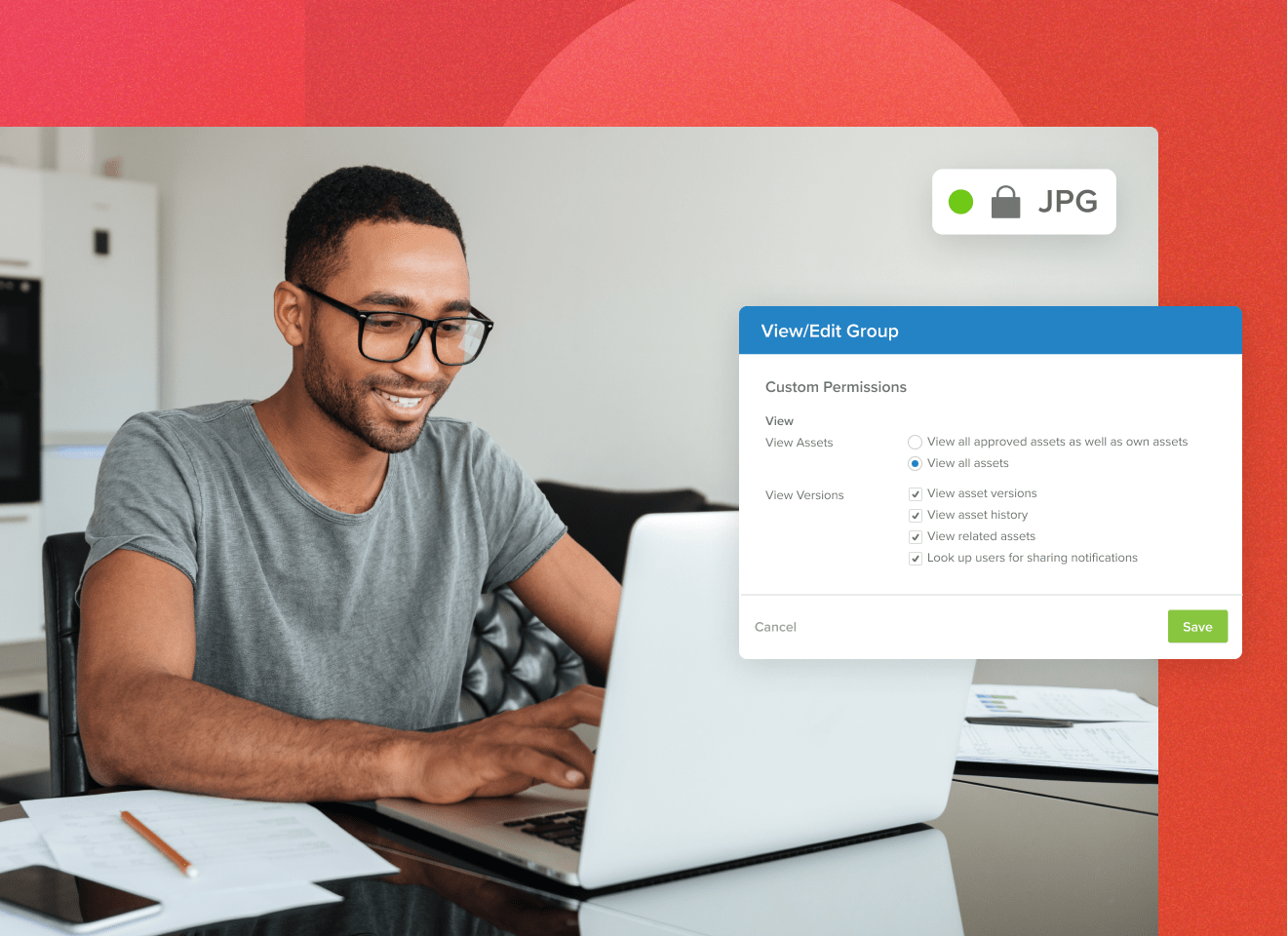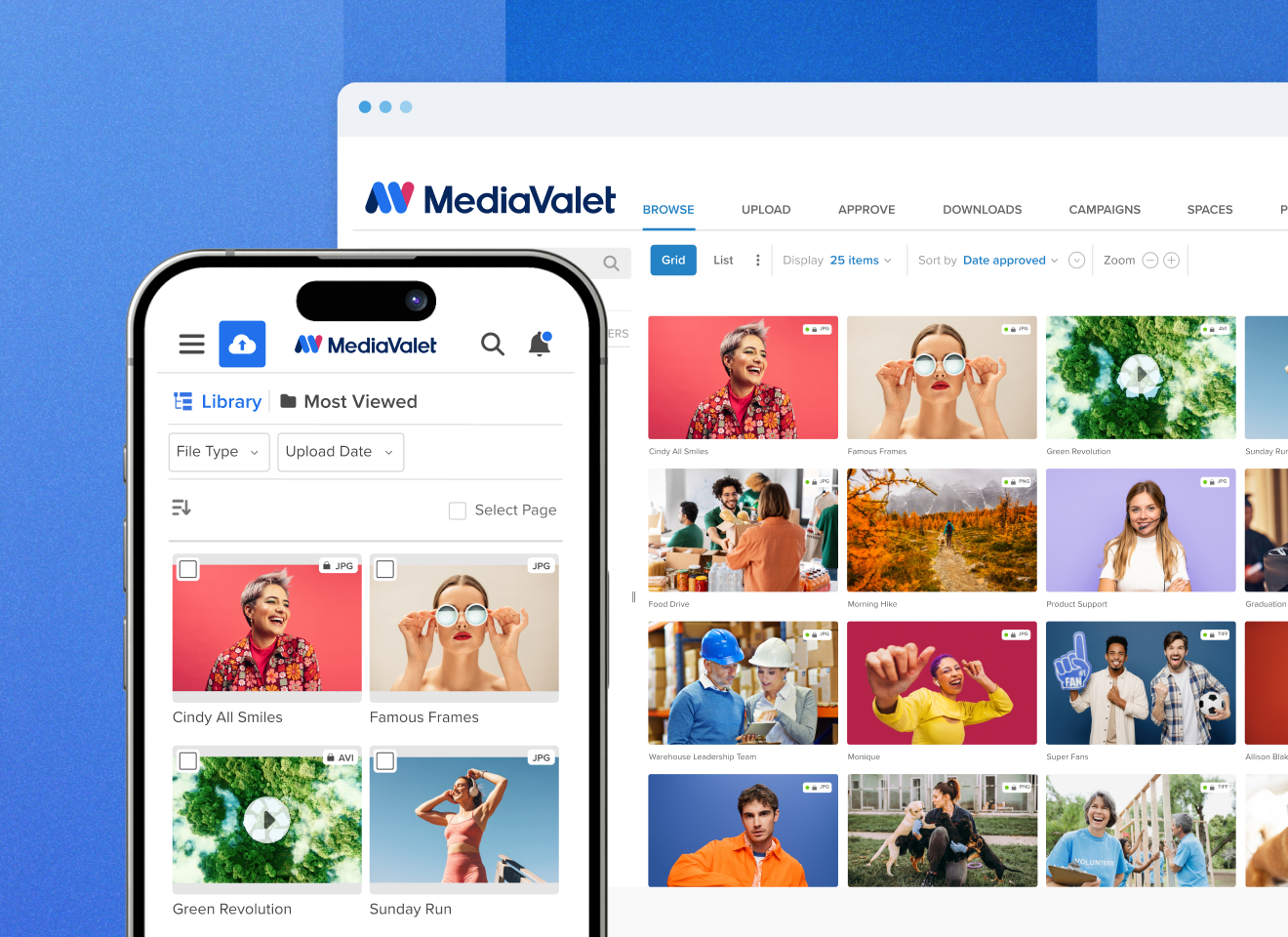Organizations are facing the daunting challenge of efficiently managing a vast array of marketing assets across multiple digital channels. But maintaining brand consistency and authority is not just a marketing team responsibility: it lies with the entire organization. It’s imperative that organizations enable and foster collaboration across various departments, and marketing asset management software (MAM) is the foundation of this.
What is Marketing Asset Management?
Marketing asset management refers to the processes and tools used to manage marketing and brand assets effectively. This includes digital assets like images, videos, presentations, documents, logos, and more that are used across various marketing efforts.
The goal is to ensure that these assets are organized, easily accessible, consistent, and utilized efficiently to maximize their value and impact in marketing strategies.
Crucial aspects to marketing asset management include:
- Centralization: Storing all marketing assets in a central location (often cloud-based) to ensure easy access.
- Organization: Categorizing and tagging assets in an intuitive way so that they can be quickly found and reused.
- Control and Security: Implementing permissions and access controls to ensure that only authorized personnel can access, edit, or distribute the assets.
- Distribution: Facilitating the easy sharing and distribution of assets to internal teams, partners, and external platforms.
- Version Control: Keeping track of different versions of assets to ensure that the most current and approved versions are used.
- Compliance and Brand Consistency: Ensuring that all marketing materials meet legal requirements and brand guidelines to maintain consistency across all channels and touchpoints.
- Performance Analysis: Tracking the usage and performance of assets to understand their impact and effectiveness in marketing campaigns.
What are the Benefits of Marketing Asset Management?
Marketing asset management enables organizations to maximize the value of their marketing assets, leading to more effective and cohesive marketing efforts. The benefits of marketing asset management include:
Effective marketing asset management enables:
- Increased Efficiency and Productivity: Reduces the time spent searching for and recreating existing materials leading to more efficient workflows.
- Improved Brand Consistency: Ensures that all marketing materials adhere to brand guidelines, regardless of who creates them or where they are distributed.
- Enhanced Collaboration: Facilitates easier collaboration between team members, departments, and external partners.
- Better Asset Utilization: Effective organization and tagging, marketing assets become more visible and accessible, reducing the likelihood of duplicates and ensuring valuable assets are fully utilized.
- Control and Security: Granular control over who can access, edit, and distribute assets not only protects intellectual property but also ensures that only approved, on-brand content is released.
- Cost Savings: Reduced need for redundant asset creation to enable quicker, more effective marketing campaigns, MAM can lead to significant cost savings.
Marketing asset management inefficiencies often lead to operational challenges like inconsistent brand messaging, and a fragmented work environment.
Enter Digital Asset Management (DAM) — a critical component of the modern tech stack that promises to revolutionize the way marketing assets are managed and how collaboration is conducted across functions within the organization.
DAM stands at the forefront of enabling more efficient marketing asset management and enhancing cross-functional collaboration, thereby unlocking an organization’s full potential.

The Impact of DAM as a Marketing Asset Management Software
Without a cloud DAM system in place, organizations often grapple with asset silos, inefficient workflows, and inconsistent branding — barriers that significantly hamper effective collaboration across marketing, sales, design, and IT departments.
DAM addresses these challenges head-on by centralizing assets, streamlining workflows, and ensuring brand consistency.
This centralization not only eliminates redundancies and inefficiencies but also fosters a unified branding approach, crucial for maintaining a competitive edge in today’s market.
But it’s not just better marketing asset management, there are trickle-down economics at work. DAM can enable marketing teams to accomplish so much more than organization:
Ensuring Brand Consistency Across Channels
Brand consistency is paramount in today’s fragmented media landscape.
A DAM system helps maintain this consistency by providing a repository for brand guidelines, logos, and templated materials. This ensures that all marketing assets adhere to the same branding standards, regardless of the channel or platform on which they are used.
By having centralized control over the distribution and usage of assets, organizations can prevent off-brand content from being published, thereby reinforcing brand identity and trust with their audience.
Measuring Asset Performance and Informing Strategy
Advanced DAM systems offer analytics and reporting tools that help marketing teams measure the performance of their assets across different channels.
By understanding which assets are performing well and which are not, teams can make data-driven decisions to optimize their marketing strategies.
These insights are invaluable for refining asset creation and distribution strategies, ensuring that marketing efforts are aligned with audience preferences and behaviors.

Enhancing Cross-Functional Collaboration with DAM
In addition to improving marketing asset management, DAM systems play a crucial role in facilitating collaboration between marketing and other departments such as sales, CX, and IT.
Seamless collaboration is not just beneficial—it’s essential. DAM serves as the linchpin for these cross-functional efforts, offering tools and features that enhance communication, streamline processes, and ensure consistency across all touchpoints.
Centralizing Communication and Feedback
Leveraging a DAM system to enable efficient and centralized marketing asset management facilitates communication and feedback on marketing assets.
This centralization is crucial for aligning marketing strategies with sales objectives, CX goals, and IT requirements.
Integrating the DAM with a PM software like Wrike enables two-way collaboration and feedback facilitating clear and actionable communication.
Integrated feedback loops mean that designers, writers, and project managers can quickly iterate content based on real-time input from stakeholders across the organization. This not only speeds up the approval process but also ensures that final assets are crafted with a holistic view of the company’s objectives in mind.
MediaValet offers several out-of-the box integrations and also offers an open API for organizations to customize the DAM to their integration needs.

Version Control and Real-Time Updates
Version control is another key feature of DAM systems that enhances marketing asset management and enables cross-functional collaboration.
By maintaining a history of revisions for each asset, DAM ensures that everyone has access to the latest version, eliminating confusion and preventing the use of outdated materials.

Real-time updates alert users to changes or new versions of assets they’re following or working on, ensuring that all team members are informed of the latest developments.
This feature is particularly valuable in fast-paced environments where marketing campaigns and materials need to be rapidly updated or repurposed across different channels and departments
MediaValet’s version control and Check in/ Check out feature enables teams to review and regulate asset versions in just a couple of clicks.
Role-Based Access and Permissions
Using a DAM system as an enhanced marketing asset management software can also support collaboration through role-based access controls and permissions.
By assigning specific access rights to different users or groups, organizations can ensure that sensitive assets are protected while still being accessible to those who need them. Sales teams can access the latest product brochures, CX can retrieve up-to-date branding materials, and IT can manage technical documentation—all within the same system.
This feature is particularly valuable in fast-paced environments where marketing campaigns and materials need to be rapidly updated or repurposed across different channels and departments.
This approach not only streamlines asset management but also supports compliance with data protection regulations by controlling who can view, edit, or distribute assets.
MediaValet customers can do more with unlimited users and user groups enhanced with our custom permission controls.

On-the-Go Access and Mobile Collaboration
In today’s mobile-first world, the ability to access and collaborate on assets from anywhere is critical.

DAM systems often offer mobile-friendly interfaces or apps that enable team members to view, comment on, and approve assets while on the go. This mobility is particularly beneficial for teams that are geographically dispersed or frequently work remotely.
It ensures that collaboration doesn’t stop when team members step away from their desks, keeping projects moving forward and allowing for timely responses to market changes or opportunities.
MediaValet Mobile enables internal teams and external stakeholders to have uninterrupted access to the DAM, from anywhere in the world, ensuring no disruptions to your workflows!
A digital asset management solution is essential to overcoming the challenges of marketing asset management and in turn, fostering a collaborative work environment.
When used cross-functionally, DAM unlocks the full potential of teams and drives organizational success. The expanding use of DAM and its evolving capabilities underscore its critical nature in the digital transformation of marketing to not only overcome current challenges but to enable organizations to position themselves for sustained success in the dynamic digital landscape.
FAQ
A high-performing marketing team is agile, data-informed, and aligned around a shared strategy. These teams reduce friction by unifying their content, workflows, and performance metrics, ensuring campaigns launch on time and at scale. Core pillars include cross-functional collaboration, brand consistency, and speed-to-market.
An efficient marketing workflow begins with ideation and moves seamlessly through planning, production, approvals, distribution, and performance tracking. It’s powered by connected systems: a DAM to centralize content, a PM tool to manage timelines, and analytics to optimize performance. The workflow should be intuitive, visual, and collaborative to reduce bottlenecks.
Unlike siloed systems that lead to version chaos, slow reviews, and asset sprawl, MediaValet offers a centralized DAM that integrates with leading PM and creative tools. This connected ecosystem eliminates rework, ensures brand compliance, and empowers teams to launch campaigns faster—with fewer headaches
When DAM and PM tools work together, teams gain visibility into the full content lifecycle—from creative brief to campaign launch. MediaValet + Wrike eliminates context-switching, improves version control, and allows marketers to find, review, and deliver content faster without digging through emails or folders.
While both Digital Asset Management (DAM) and Marketing Asset Management software (MAM) help organize and distribute content, their focus and scope differ.
A Digital Asset Management (DAM) platform is the central source of truth for all digital assets across an organization, from marketing and creative files to product videos, training materials, and brand guidelines. It’s designed to store, manage, search, and distribute content securely at scale, supporting collaboration across departments, regions, and external partners.
Marketing Asset Management (MAM) software, on the other hand, is typically a subset of DAM focused on marketing use cases. MAM solutions often specialize in campaign materials, templates, and brand assets used by marketing teams to maintain consistency and streamline go-to-market efforts.
In short, DAM powers the entire content ecosystem, while MAM supports marketing execution within that ecosystem. Most enterprise DAM platforms, like MediaValet, include robust marketing asset management capabilities plus advanced tools for video management, AI tagging, proofing, templating, and brand portals, making them the more scalable, organization-wide solution.
Related Articles
What a DAM good read!
Fuel your DAM knowledge by browsing our Resource library




